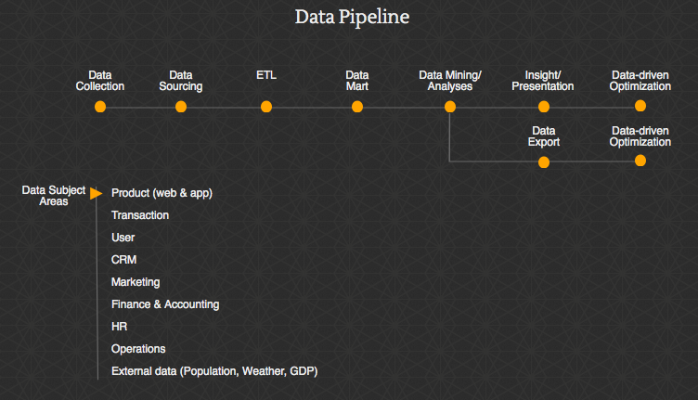When people asked what I do for a living at conferences or parties, I told them I run data strategy. Their first response was “oh, that’s cool”. Then they paused for a moment and asked “what do you do exactly?”
After spending fifteen minutes explaining all the aspects of my job, I either totally confused my audience or bored them to death.
So I set out to develop an elevator pitch, something as punchy as “I am a photographer who specializes in marine life”. I thought I could get some help from online job postings. Searching “data strategy” on LinkedIn returned 84 listings. Few of them described what I do. By contrast, the search on “data scientist” returned 40 times more results.
I was not hired per a job description. I was lucky to convince Eventbrite to create the role for me.
My argument was pretty simple: think of all the data-related challenges the company faces, how many of them are technical, how many are organizational?
Most data-driven organizations have the following data pipeline.

These functions are owned by different groups. Many problems arise from the lack of cross-function understanding of data. For example, analysts complain about the variations of a single metric. They feel they have little influence over the engineering team to impose consistent tagging. Engineers, on the other hand, complain about analysts’ incomprehension of the technical complicity.
Such friction can be reduced by someone who operates on the “full stack” – someone who has the domain knowledge in each area, as well as the organizational skill to connect the dots. Data strategist is one of those people.
Data strategy development reverses the data pipeline. It starts by asking what data and insight are critical to the business’s short, medium, and long-term growth. Though the cost of storing and processing data gets cheaper, the cost of generating insights increases as more and more operations become data driven. Data strategy should be aligned with the business strategy, prioritized to address the biggest opportunities and highest risks. First, data strategist thinks like a business operator.
Business opportunity for a web-based eCommerce company can be developing mobile user experiences (both mobile web and app). Increasing competition from mobile-only competitors poses significant risk. Data strategist, together with engineering and analytics, decides on the success metrics to measure the new mobile products. The metrics are then translated into data needs; and data needs into technical requirements for tracking. Data strategist can help to enforce the consistency across devices, so user experiences on different platforms can be compared side by side. Data strategist, secondly, is an analyst. She or he understands what questions to ask; and how data becomes metrics and then insights.
Once the mobile products are available, marketing decides to launch a few mobile campaigns. One of the campaigns is a banner on the homepage, encouraging web users to download the app. Marketing would like to know the effectiveness of this campaign compared to another campaign they purchased from an app ad network. This request poses some real technical challenges. The traditional cookie based web tracking no long applies to app. Data strategist works with engineering to explore the technical workarounds, and evaluates external tools that may provide a solution. She or he also partners with legal to make sure the privacy policy is updated. Data strategist, thirdly, is a technologist. The technical knowhow helps to make tradeoffs; avoiding making data collection a burden on the engineering resources.
Multiple functions, competing priorities, tight resources, various teams touching one data point…data strategy cannot operate unless cross-function processes are established. A company-wide data roadmap is an example of such process. Data strategist, fourthly, is an organizer.
Lastly, data strategist is a communicator. She or he is the broker of domain knowledge from one function to another. She or he funnels the downstream constraints to the decision makers; and translates the overall strategy down to individual data stakeholders. She or he champions for the investment in data infrastructure and personnel. When issues arise, she or he assembles a team and coordinates the efforts. Best practices are shared, training held to distribute the understanding of data evenly across the organization.
If I have to summarize all these responsibilities into one sentence, I’d say my job is to help organizations managing their data assets, and finding the best ways to surface insights from the data. Still not as punchy as the underwater photographer. For the fellow data strategist out there, if you have a better version I would love to hear it!
Thank you for sharing the information very very useful. It is very very pleasant to read this article from your website.
Android Developer ANDROID DEVELOPER
I would consider to simplify it as following:
As a data strategist, I am responsible for providing right data to right people (business customer) at right time, so customer can derive insights to make business decision. I also ensure that reliable data is provided securely at speed and scale.